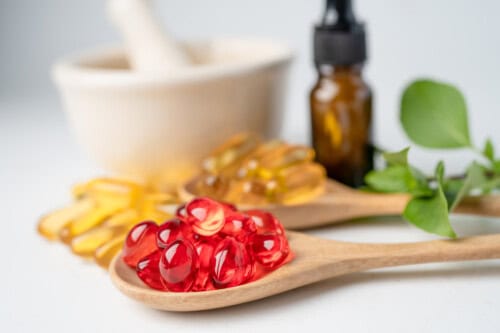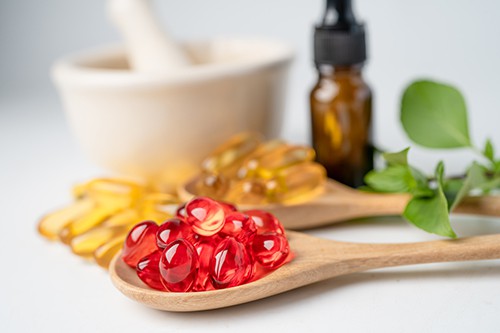When prescribing medications to patients, drug interactions can be a very stressful consideration. While Family Nurse Practitioners may have all the answers about how a specific drug works and how it will help a patient’s symptoms, it is impossible to memorize all of a drug’s potential interactions. To avoid both drug-drug and drug-nutrient interactions and help keep patients safe, nurse practitioners can use digital tools such as electronic health records and mobile apps.
How can electronic health records help identify potential drug-drug interactions?
Electronic health record (EHR) systems have many helpful tools that nurse practitioners can leverage to improve patient safety and save time. First, EHR platforms all have alert systems to notify nurse practitioners when they try to prescribe a medication that has potential drug-drug interactions with something else already on the patient’s medications list. This great safety feature will flag conflicting medications or dosage levels that are unsafe. With this, nurse practitioners can avoid easy-to-make, but life-threatening mistakes.
How can nurse practitioners find alternative medications when drug interactions exist?
Another great tool of EHR systems is their ability to make recommendations about related medications. When inputting potential medications to prescribe, EHR systems can populate a list of similar medications. That way, if a preferred prescription has a drug-drug interaction, nurse practitioners can easily find a similar drug that will be safer for their patient. This allows nurse practitioners to review and consider many pharmaceutical treatments at once and decide the best treatment plan based on the greatest potential benefits, the fewest drug interactions, and the most minimal side effects.
What other technologies can help catch drug-drug interactions?
Almost any program nurse practitioners use to advise you on drug dosing will also have this important information. Nurse practitioners know it is important to review a drug’s class and the mechanism of action to avoid patient allergies and drug interactions. Understanding a drug’s mechanism of action helps nurse practitioners consider the many ways a patient’s medications will affect their body. This is especially true for patients with specific disorders or conditions and patients who are older and may have limited liver or kidney functioning.
In addition to electronic health record systems, electronic medication management systems (EMMS) are a powerful tool for nurse practitioners to prescribe safely. With an EMMS, nurse practitioners can read all about a particular medication’s life cycle, from dosing and administering to reviewing, deprescribing, and disposing of medications. An EMMS provides nurse practitioners with essential information to educate patients when they start new medications.
Top mobile apps for nurse practitioners to monitor drug-drug interactions
Another helpful technology for preventing drug-drug interactions is nurse practitioner mobile apps. It can be extremely convenient to have the answers you need right on your phone, especially if you are not at a computer at a particular moment. Several mobile apps, like Pocket Pharmacist, MedScape, and Micromedex, provide nurse practitioners with drug information, dosing considerations, and potential interactions through a simple search. This can be helpful for in-the-moment conversations with a patient or double-checking drug interactions before you prescribe.
Related: Drug-Drug and Drug-Nutrient Interactions: Avoiding Common Problems
Why is grapefruit juice dangerous to consume when on certain medications?
Drug-drug interactions aren’t the only thing nurse practitioners need to look out for. Drug-nutrient interactions are common and can be just as dangerous. For example, nurse practitioners surely know to caution patients against consuming grapefruit juice when they are on a number of different medications. This is because grapefruit juice blocks certain enzymes in the intestine from properly metabolizing drugs. When patients consume grapefruit juice on certain medications, more of the medication will enter the bloodstream and it will stay in the body longer.
This can be quite dangerous, so it is an important dietary restriction for patients to be aware of and keep in mind for the length of their prescription. Grapefruit juice is one example of a drug-nutrient interaction, but there are plenty of other examples, too.
Why are patients advised to take certain medications with food?
Many medications need to be taken with or without food. When patients hear this, they usually assume it is recommended simply to help avoid an upset stomach with a particularly harsh medication. In some cases, this may be true. However, in many other cases, food and digestive processes actually impact how the body absorbs and responds to a medication.
Some drugs are actually better absorbed when taken with food, such as sertraline (zoloft), which showed 33% better uptake when taken with a meal. Other medications have decreased drug absorption with food. Some medications can be made dangerous when combined with food, and other medications can be canceled out altogether by foods. For example, dairy products shouldn’t be consumed at the same time as antibiotics because the calcium in the dairy can bind to the antibiotics and render them ineffective. Another example is leafy greens and aspirin, as foods high in Vitamin K decrease aspirin’s efficacy as a blood thinner.
Where can nurse practitioners get information on drug-nutrient interactions?
It is important for nurse practitioners to know about drug-nutrient interactions to be able to properly advise patients about how to take a new medication. For these answers, nurse practitioners can look to drug-nutrient interaction guidelines. DNI guidelines provide information about what foods patients need to avoid and when certain medications should be taken. DNI checkers are common in apps that check for drug interactions, and they typically include foods, alcohol, and vitamins or supplements to watch out for when taking a prescribed medication.
In conclusion
Monitoring a patient’s medication list and diet are key for prescribing safely. There are plenty of app, websites, and features in EMR systems for nurse practitioners to check for drug-drug interactions and drug-nutrient interactions. In the future, nurse practitioners can look forward to even safer prescribing thanks to artificial intelligence systems that are being trained to predict drug interactions. Some computer learning is already available in e-prescribing platforms, and the technology is only going to continue getting better.
Earn CE hours with our online course on Drug-Drug and Drug-Nutrient Interactions: Avoiding Common Problems (free with Passport Membership)!






